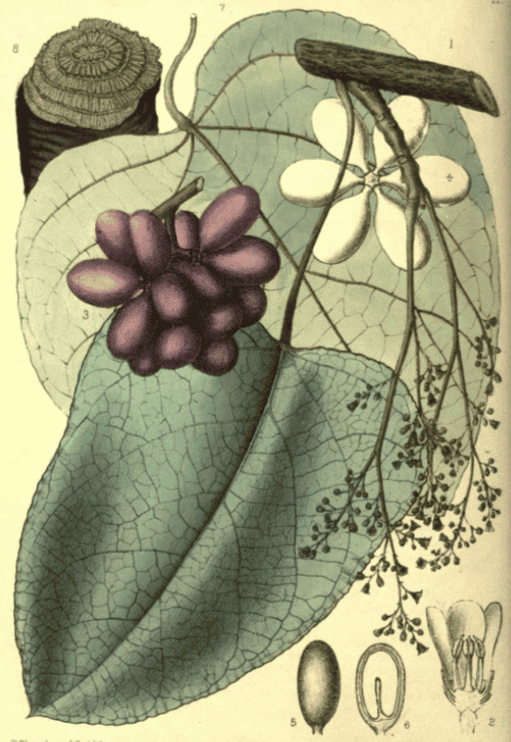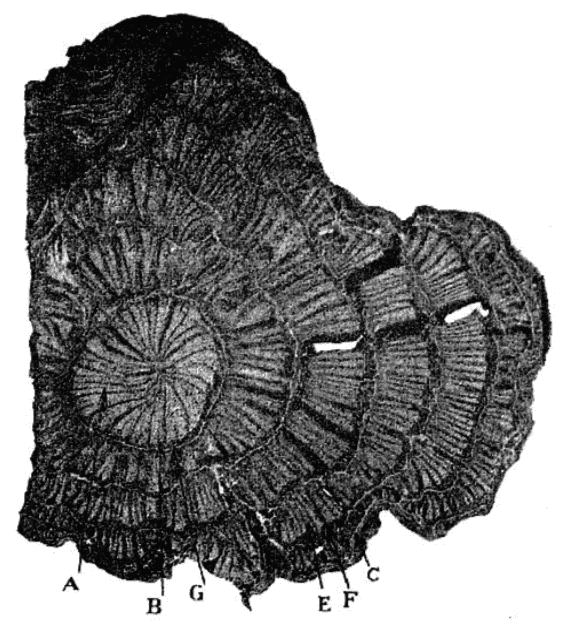Chondrodendron, PareiraCurare, Velvet Leaf. Ice VineNan Mei Fang Ji (TCM) |

|

|
 Chondrodendron tomentosum
Chondrodendron tomentosumBentley and Trimen, Medicinal Plants, Vol 2, 1875
 Cross-section of the root
Cross-section of the rootManual of Organic Materica Medica, Sayre, 1879
Botanical name:
Chondrodendron tomentosum (syn. C. scabrum)
A number of related plants were available as varieties of Pareira
Parts used:
Root, Stem
Temperature & Taste:
Bitter, slightly Sweet. Toxic
Constituents:
Alkaloids: delta-tubocurarine, L-curarine
Uses:
1. Clears Damp, Promotes Urine:
-chronic urinary inflammations, chronic Cystitis
-Edema, Dysuria, painful urination, constant desire to urinate
-Gravel, Stones
-Rheumatism
-Jaundice
-Leukorrhea, Gonorrhea
2. Moves the Blood:
-Trauma, Bruising
-promotes Menstruation
3. Settles Wind, Stops Spasms:
-Cramps, Convulsions
-Hypertension
-Tetanus
-Mental Illness, ‘Madness’
4. Resists Poison:
-Snake Bite (wine infusion internally, crushed leaf topically: Brazil)
Dose:
Powder: 1–2.5 grams (1–2 scruples)
Infusion: 3–6 grams (up to 9 grams) has been taken over the course of a day.
Tincture (1:5 in 50% alcohol): 50–70 drops
Strong Tincture (8 oz. to 1 pint of 76% alcohol): 1–10 drops
Fluid Extract (1:1): 1/4 to 2 drams
Solid Extract: 650–1300mg
Comment:
1. Curare, obtained from this and related plants has been used as a paralyzing arrow poison by native South Americans.
2. Tubocurarine chloride is used as a muscle paralyser during surgery.
Substitute:
1. Stephania glabra is used synonymously in India.
2. Its Chinese name indicates a variety of Fang Ji (Stephania) suggesting Stephania tetrandra (Fang Ji) may also be used similarly.
3. Bearberry
4. Pareira may be a suitable less toxic substitute for the Birthworts.
Main Combinations:
1. Chronic Urinary inflammations, Dysuria:
i. Pareira, Buchu
ii. Pareira, Bearberry
Major Formulas:
Cautions:
1. Toxic in overdose. Its use is restricted in many countries.
2. Not used during Pregnancy
Toxicity:
1. Toxicity is especially associated to its toxic compounds entering the bloodstream. So for example, cuts or sore in the mouth can produce toxic reactions due to the toxic compounds directly entering the blood. If there is no direct route into the bloodstream it is relatively safe in therapeutic doses.
2. ‘Overdoses of tubocurarine (and other curare alkaloids) can cause respiratory paralysis and hypotension’. (Duke)
3. LD50 of the alkaloids is less than 1mg/kg in mice.
Main Preparations used:
Infusion, Decoction, Tincture
Infusion of Pareira:
Pareira 3 drams
Boiling Water 1 pound
Infuse, strain. To be taken over the course of a day. (Niemann)
Decoction of Pareira:
Pareira 1 oz.
Spring Water 2 pounds
Boil to 1 pound. Dose: 3 oz., three times daily.
Tincture of Pareira:
Pareira root 1 part
Alcohol (50%) 5 parts
Dose: 50–70 drops. (Wirtemberg)
-
Extra Info
-
History
